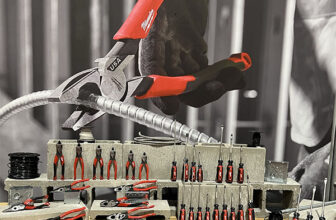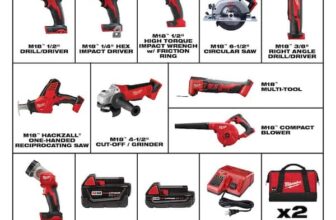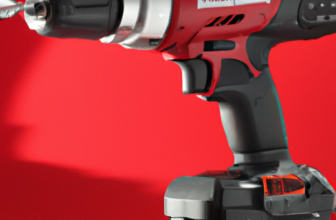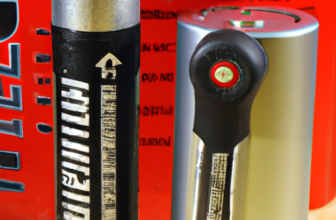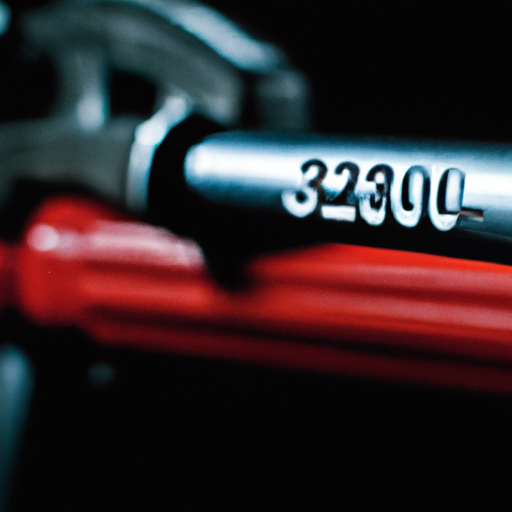
This post may contain affiliate links which means I may receive a commission for purchases made through links. Learn more on my Private Policy page.
You’re about to learn the essential skill of deciphering a Milwaukee Tool serial number. Whether you’re a seasoned professional or a DIY enthusiast, understanding these numbers will help you make informed decisions about your tool purchases and replacements. In this concise article, we will guide you through the process step by step, ensuring that you never get lost in the confusing array of digits and letters again. So, let’s dive right in and uncover the secrets behind reading a Milwaukee Tool serial number!
Locating the Serial Number
Checking the Tool Body
When trying to locate the serial number of your Milwaukee tool, start by examining the tool body itself. Look for any engraved or stamped numbers on the tool, typically located on the side or near the handle. Milwaukee tools often have the serial number imprinted directly onto the body, making it easy to find.
Referencing the Packaging
If the serial number is not visible on the tool body, the next step is to refer to the packaging. Check the box or packaging that the tool came in. Manufacturers often include the serial number on the packaging label or may provide a separate label that displays the serial number. Take a close look at all sides of the packaging to ensure you don’t miss it.
Analyzing the Manual or Documentation
If you still can’t find the serial number on the tool or the packaging, consult the manual or any accompanying documentation that came with the tool. Manufacturers often include the serial number within the paperwork or provide instructions on where to find it. The manual may have a specific section dedicated to serial number identification, so be sure to review it thoroughly.
Understanding the Serial Number Format
Decoding the Digits
Once you have located the serial number, it’s time to decipher its format. Milwaukee tool serial numbers typically consist of a combination of numbers and letters. Each digit or group of characters has a specific meaning, which we will dive into in the following sections. By understanding the format of the serial number, you can gather valuable information about your tool.
Identifying Manufacturing Date
One important aspect of the serial number is that it often reveals the manufacturing date of the tool. The serial number may include codes or digits that indicate the year and month the tool was produced. This information can be useful for tracking the age of your tool and assessing its overall condition.
Determining Manufacturing Plant
Additionally, the serial number of a Milwaukee tool can also provide insight into the manufacturing plant where the tool was produced. The serial number may include specific codes or letters that indicate the production facility. This can be particularly helpful if you are interested in knowing where your tool was made or if you encounter any manufacturing-related issues.
Different Serial Number Formats
Older Tool Serial Number Format
Milwaukee has utilized different serial number formats over the years, so it’s essential to understand the distinctions. In the past, Milwaukee’s serial numbers consisted of a combination of numbers and letters in varying arrangements. These older formats may include specific codes or prefixes that denote the tool series, manufacturing date, or other relevant information. Familiarizing yourself with the older formats will help you correctly interpret serial numbers from older Milwaukee tools.
Newer Tool Serial Number Format
More recently, Milwaukee has transitioned to a standardized serial number format, which is easier to understand and decode. The newer format typically consists of a numeric section followed by an alphabetic section. Each section contains important information about the tool, such as the model number and manufacturing date. Understanding the structure of the newer serial number format will enable you to gather valuable insights at a glance.
Example Serial Numbers
To provide you with a better understanding of Milwaukee tool serial numbers, let’s look at some examples. An older serial number format might look like “123ABC456,” while a newer format could be “123456A7B8C.” By analyzing these examples, you can start to see how the numbers and letters are arranged and begin to decode their meaning.
Interpreting the Serial Number
Identifying the Tool Model Number
One of the essential pieces of information you can gather from a Milwaukee tool serial number is the model number. The model number identifies the specific product or tool variant. By decoding the serial number and referencing the manufacturer’s documentation, you can determine the model number of your tool. This information is valuable when seeking replacement parts or contacting customer support for assistance.
Determining the Manufacturing Date
As mentioned earlier, the serial number often holds clues about the manufacturing date of the tool. By examining the serial number’s numeric and alphabetic sections, you can identify the year and month when the tool was produced. This knowledge allows you to better understand the age of your tool and make informed decisions regarding its maintenance or potential warranty coverage.
Decoding Additional Information
Beyond the model number and manufacturing date, the serial number may contain additional information about the tool. This could include details regarding any revisions or series updates, specific product versions, or even manufacturing plant codes. By delving deeper into the serial number and using available resources, you can uncover valuable insights and gain a more comprehensive understanding of your Milwaukee tool.
Identifying Tool Model Number
Analyzing the Numeric Section
The numeric section of the Milwaukee tool serial number typically represents the model number. This set of numbers indicates the specific product or tool variant within a particular series. It is crucial to accurately decipher the numeric section to identify the correct model number. Cross-referencing this section with the manufacturer’s documentation will allow you to determine the exact model of your tool.
Understanding the Alphabetic Section
In the newer serial number format, the alphabetic section holds important information about the tool. It may include codes or letters that provide insights into the manufacturing date, revisions, series updates, or other relevant details. Paying attention to this section and understanding its significance will enhance your ability to interpret the serial number accurately.
Potential Model Number Variations
It’s essential to remember that the model number can vary depending on the specific tool or product range. Some tools may have a more complex model number structure, including a combination of numbers, letters, and even special characters. When dealing with unique model number variations, it’s crucial to consult the manufacturer’s documentation or contact customer support for clarification.
Determining the Manufacturing Date
Decoding the Date Code
The manufacturing date is a critical piece of information found within the Milwaukee tool serial number. To determine the manufacturing date, you must decode the date code embedded in the serial number. This code typically consists of numbers or letters that signify the year and month when the tool was produced. Understanding how to interpret the date code will help you pinpoint the manufacturing date accurately.
Understanding Year and Month Codes
In the Milwaukee tool serial number, the year and month codes are usually represented by specific digits or letters. Each digit or letter corresponds to a specific year or month within a predefined code system. By referencing the manufacturer’s guidelines or available online resources, you can match the year and month codes in the serial number to accurately identify when your tool was manufactured.
Recognizing Date Code Variations
While Milwaukee has established a standardized date code system, it’s worth noting that there may be variations in how the codes are presented. Depending on the tool’s age or specific product line, the date codes may be arranged differently or follow a slightly different format. Familiarize yourself with the potential variations to ensure accurate interpretation of the manufacturing date from the serial number.
Decoding Additional Information
Analyzing Plant or Manufacturing Codes
In some cases, Milwaukee places plant or manufacturing codes within the serial number. These codes are represented by specific letters, numbers, or a combination of both. By referencing the manufacturer’s documentation or contacting customer support, you can uncover the meaning behind these codes. Understanding the plant or manufacturing codes can provide valuable insights into the origin of your tool and any relevant details associated with the specific production facility.
Identifying Revision or Series Codes
Another type of additional information that might be present in the serial number is revision or series codes. These codes often indicate any updates, improvements, or revisions made to a particular tool model or series. By identifying the revision or series code from the serial number, you can determine if there have been any significant changes to your tool and gather relevant information for maintenance or replacement purposes.
Determining Product Version or Series
Lastly, the serial number may contain information about the product version or series. This information is particularly relevant when manufacturers release different iterations of a tool or have distinct series within their product lineup. By interpreting the serial number and recognizing any product version or series codes, you can ensure that you are obtaining accurate information and selecting the right accessories or replacement parts for your specific tool.
Checking Old Tool Serial Numbers
Identifying Older Serial Number Formats
Milwaukee has employed different serial number formats over the years. When dealing with older Milwaukee tools, it’s important to recognize the specific format used during that period. Older serial number formats might require a different decoding process or vary in structure compared to newer tools. By identifying the older serial number format, you can adapt your approach to properly interpret the serial numbers.
Understanding Limitations and Variations
When dealing with older serial numbers, it’s essential to understand that there may be limitations or variations in the information they provide. Older Milwaukee tools may not have as comprehensive or detailed serial numbers as their newer counterparts. Some older formats might only include basic information such as model number and manufacturing date, without any additional codes or details. Take this into account and rely on other identifying features if necessary.
Contacting Milwaukee Tool for Assistance
If you encounter difficulty interpreting an older Milwaukee tool serial number or require additional information, don’t hesitate to reach out to Milwaukee Tool’s customer support. Their knowledgeable staff can provide guidance, discuss any unique variations in serial number formats, and assist you in understanding the details specific to your tool. Milwaukee Tool’s customer support is always ready to help you make sense of your tool’s serial number.
Properly Recording the Serial Number
Documenting for Warranty and Registration
Recording the serial number of your Milwaukee tool is crucial for warranty and registration purposes. When purchasing a new tool, make sure to document the serial number along with other relevant information. This documentation will come in handy if you ever need to claim warranty coverage or register your tool for additional benefits. Keep the recorded information in a safe and easily accessible place.
Noting Serial Number for Future Reference
Even if you don’t plan to register the tool or you’re unsure about the tool’s warranty status, noting the serial number for future reference is highly recommended. Keeping a record of the serial number allows you to easily retrieve the information if needed, such as when contacting customer support, searching for compatible accessories, or selling the tool in the future. It’s always better to have the information readily available when required.
Storing Serial Number Securely
To ensure that you won’t lose the serial number information or have it misplaced, it’s essential to store it securely. Consider creating a dedicated folder or storage space for all your tool documentation, including the serial numbers. You can also use digital tools like password-protected spreadsheets or cloud storage to keep the information safe and easily accessible from anywhere. Properly storing the serial number ensures that you can retrieve it whenever necessary.
Benefits of Knowing the Serial Number
Verification of Tool Authenticity
By knowing how to read and interpret the Milwaukee tool serial number, you gain the ability to verify the authenticity of the tool. This knowledge helps you identify genuine Milwaukee products and distinguish them from counterfeits or unauthorized replicas. Ensuring that your tool is authentic provides peace of mind and guarantees the quality and performance you expect from Milwaukee.
Accessing Customer Support and Service
When contacting Milwaukee Tool’s customer support or seeking assistance for your tool, knowing the serial number is invaluable. Customer support agents can quickly access relevant details about your tool and provide accurate guidance or troubleshooting steps. Sharing the serial number with customer support ensures that you receive personalized assistance tailored to your specific tool model and manufacturing details.
Obtaining Warranty Coverage
The serial number is a vital piece of information when it comes to warranty coverage. Manufacturers often require the serial number to validate warranty claims and confirm the product’s authenticity. By knowing the serial number and having it readily available, you can ensure a smooth warranty claim process if you encounter any issues with your Milwaukee tool. Warranty coverage allows you to have repairs or replacements done promptly and often at no cost to you.
Understanding how to read a Milwaukee tool serial number opens up a world of valuable insights about your tool. By locating the serial number, decoding its format, and interpreting the information it provides, you can identify the tool model, determine the manufacturing date, and uncover additional details. Recording the serial number for warranty and future reference, as well as knowing the benefits of this knowledge, enhances your overall tool ownership experience. So, take the time to familiarize yourself with your Milwaukee tool’s serial number and enjoy the benefits it brings.
This post may contain affiliate links which means I may receive a commission for purchases made through links. Learn more on my Private Policy page.



